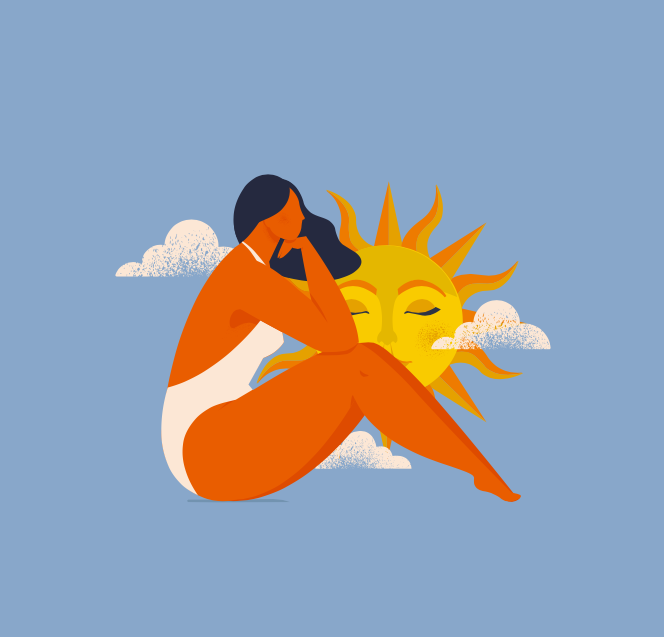CNM (The College of Naturopathic Medicine) always have amazing health advice to offer in our magazine. In our Summer 2021 issue, naturopath and CNM graduate Michelle Sanchez wrote about how we can protect our skin at this sun-drenched time.
Sun Cream Alternatives
How to protect your skin naturally
by Michelle Sanchez
At this time of year, hundreds of bottles, sprays and tubes of sun cream take prime position in personal care shops and supermarkets. Sun cream is considered an essential purchase for those heading away for a break in the sunshine. However, it is worth taking some time to consider which products will be most beneficial for your health and the environment.
What is sunscreen and how does it work?
Sunscreen, also known as sun cream or sunblock, is a topical product which is applied to the skin; the aim being to protect it from the sun. It works by absorbing or reflecting ultraviolet rays from the sun, thereby preventing sunburn. There are two types of ultraviolet rays: Ultraviolet A (UVA) which is a long wavelength associated with skin burning; and Ultraviolet B (UVB) which is a shorter wavelength linked to skin ageing. Around 95% of the ultraviolet rays which reach the skin through sunlight are UVA. When choosing a sunscreen, it’s essential to check that it contains both UVA and UVB protection, as both ultraviolet rays are considered harmful for your skin.
Be sunscreen aware
If you look at the back of your sunscreen packaging, you’ll see a long list of ingredients that you may not be familiar with. These chemically complex ingredients have been specially formulated in a laboratory setting to block UVA and UVB rays, but they can affect the body in ways that are best avoided.
Here are a few sunscreen ingredients to look out for:
• Oxybenzone, also called Benzophenone-3, is a common ingredient in sunscreens due to its efficacy at reducing UV exposure. It is able to penetrate the skin and leach into the blood; studies have shown that traces of oxybenzone can be found in breast milk. This chemical has been linked to skin allergies, hormone disruption and lowered birth weight. Oxybenzone is also hazardous to ecosystems, as it bleaches and deforms coral and contaminates fish.
• Octinoxate (Octyl methoxycinnamate) is another common ingredient used in sunscreens as a UV filter. It has been linked with reproductive and developmental issues and hormone disruption. Octinoxate has also been linked to the reduction of thyroid hormones in the blood, which impacts metabolism.
• Homosalate is known to disrupt hormones (progesterone and androgens) and increase the production of oestrogen in the body. The reason that homosalate is used in sunscreens is that it has the ability to absorb short-wave UVB rays; these are the rays that can damage the DNA of cells.
• Octocrylene is another UV filter widely used in sunscreens. It absorbs UVB rays and short UVA rays. The issue is, when exposed to UV light, octocrylene produces free radicals which can cause damage to cells, making them mutate. This chemical is highly allergenic and is able to seep through the skin, accumulating in the body.
• Fragrances in sunscreens are another concern, as they contain chemicals that have been linked to a host of health conditions.
Always read the labels of sunscreen products to check the ingredient list, even when the product is labelled “natural” or “organic.” Quite often, these products do contain some chemicals. If you are in doubt about any of the ingredients, call the brand directly and ask them questions.
How to protect your skin naturally
• Avoid the sun during peak times of the day, from 10 a.m. until 4 p.m., as this is when the sun is strongest. Instead, venture outside in the early morning or late afternoon. Use the ‘shadow rule’ to determine when you should go out in the sun. If your shadow is shorter than your height, avoid the sun, as UV rays will be too strong.
• Seek out shade wherever possible. Use an umbrella or beach tent when at the park or beach.
• Wear a wide-brimmed hat and clothing with UV protection, such as a rash guard or a rash vest, which offer protection up to UPF 50+. The more coverage your body has from the sun, the less chance you have of burning.
• Be aware that you can still suffer from sunburn in the water or if it’s cloudy.
• Protect your eyes with sunglasses that block out both UVA and UVB rays. Opt for sunglasses with a UV rating of 400 plus, as excessive sun exposure can increase your chances of developing eyes diseases such as cataracts and macular degeneration.
• Eat more skin-protecting foods like blueberries, watermelon, carrots, leafy greens and cauliflower. These foods are high in antioxidants, vitamin C and beta-carotene, which are essential nutrients for skin health. Watermelon and tomatoes are particularly high in an antioxidant called lycopene, which has the potential to act as a natural sunblock.
• Make your own natural sun cream at home! It’s not as complicated as you might think – you can easily make a natural sun cream with a few ingredients. Some natural carrier oils have a high SPF factor, including carrot seed oil (SPF 38-40), raspberry seed oil (SPF 28-50), wheatgerm oil (SPF 20), avocado oil (SPF 4-15) olive oil (SPF 2-8) and coconut oil (SPF 2-8). You can blend one of the above oils with beeswax and zinc oxide for a natural sunscreen. It is important to obtain organic produce (or Soil Association certified) for best results, and always do a patch test.


